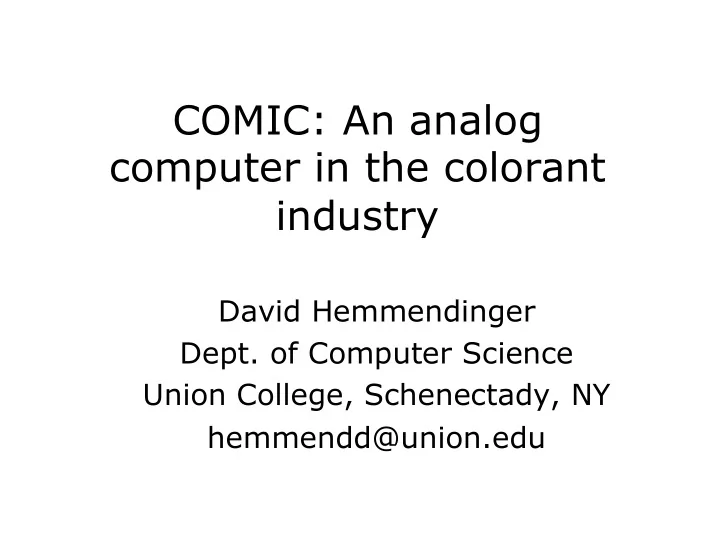

COMIC: An analog computer in the colorant industry David Hemmendinger Dept. of Computer Science Union College, Schenectady, NY hemmendd@union.edu
The problem Find the proportions of several pigments to mix to match a given sample. “Industry’s number-one color problem” (1963) Why is it hard?
Colors: A 3-dimensional space Coordinates: R,G,B or X,Y,Z (CIE* tristimulus values) X,Y,Z of mixture of lights: sum of X,Y,Z values of components *CIE: Commission Internationale d’Éclairage
Color Mixing Subtractive Additive mixing mixing of of lights absorbing filters sum tristimulus spectral transmission values data needed
Additive matching X = c 1 X 1 + c 2 X 2 + c 3 X 3 X Y = c 1 Y 1 + c 2 Y 2 + c 3 Y 3 Z = c 1 Z 1 + c 2 Z 2 + c 3 Z 3 Given X,Y,Z of a color, and three lights, solve the equations for the amounts c i of those lights to match the given color.
Mixed pigments, dyed fabric: harder Kubelka-Munk theory(1931): uses absorption and scattering by particles and substrate
K, S of a mixture: linear functions of component K, S values Pastel paints, dyed fabric: assume all scattering due to white pigment or fabric (S w ). Result: linear equation in c 1 ,c 2 ,c 3 : quantities of the three colorants
Color also depends on the illuminant. Colors may match in one light, not in another: metamerism . fluorescent incandescent light light reflectance curves
1940s, 1950s: graphical techniques to use the K/S formula: tedious! 1955 analog device:
Davidson & Hemmendinger, Inc • Formed 1952 by electrical engineer and physicist • color measurement and specification • produced Munsell Color Atlas , 1956 • standards and measurements: blood tests peach grading false teeth tropical bird colors
COMIC, 1958 Analog computer 16 simultaneous equations, 3-5 unknowns (c i ): K/S evaluated at 16 wavelengths across spectrum
K/S for sample batch “fudge factor” dials tristimulus difference computer plug-in boxes concentration dials
a: beige sample. Try yellow, red, green dyes. b: add green; c: add red; d: add yellow: match e: try black, not green: imperfect spectral match
Tristimulus If imperfect match Difference •use TDC Computer zero meters for (TDC) tristimulus (XYZ) match •may be metameric •can switch TDC to another illuminant to assess degree
batch settings 2nd trial: set K/S of first trial. adjust colorant concentration dials: add or subtract to get match -- or use TDC
Industrial use p plug-in ~200 sold, 1959-1967 colorant boxes $10,000, later $18,000 plug-in boxes: $40 each typical results: reduce trials by 35-40% (Monsanto, Coats & Clark) best for fabric dyeing, pastel paints
Merits: match in 5-20 min, not hour or more operator used expert knowledge emphasized reflectance curves, not just perceived color Limitations: manual data entry colorant boxes: single concentration needed “fudge factors” for deep colors K/S equation: not quite linear
One opinion: www.rpdms.com/wineyrpt.html -- author preferred a digital program
Other special-purpose computers Redifon, 1965 Pretema FR-1, 1966 digital analog/digital
D&H Digital COMIC II, 1967 • 400 boards, magnetic drum, paper tape • solved more general equations • few sold. “Obsolete the day it came out.” -- Ralph Stanziola, D&H salesman
Outdated, the COMIC had educational value -- Dec, 1969 Am. Dyestuff Reporter
Digital computing 1959, IBM: Am. Cyanamid computer not enough to solve color equations 1961: Imperial Color, UK: Instrumental Match Pgm : colorimetric (XYZ) matches -- couldn’t handle metamerism 1963: Am. Cyanamid, Computer Color Match (CCM) found all recipes for 3 out of 10 dyes, with costs, metameric index -- IBM 1620, later 1130
Clients sent sample measurements, got results within a day 1967: IBM library program for 1130, later 360 systems CCM, IBM programs solved matrix equation by approximation and iterative refinement Later versions handled deep colors well, as the COMIC did not
Minicomputers: well-suited to color- matching computations 1970, Applied Color Systems (ACS), co-founded by Mr. Stanziola (from D&H), ran programs on time- sharing DEC 10 Later, used PDP-11s extensively Merged with Swiss Pretema, UK Instrumental Colour Systems to form Datacolor, 1990
Comparison COMIC operator: “in the loop”. Adjusted concentration dials to zero the dots: inverting a matrix With metameric matches, iteratively modified dial settings to get colorimetric (XYZ) match Analog computing: less highly- mediated experience
Conclusion The COMIC: right degree of automation for the time Drew on dyer’s experience Educational role: taught importance of spectral reflectance curves Digital programs provided more information, had fewer limitations Risks of automation:
Conclusion, II Charles Mertz (Minolta, former ACS VP), 2000 Put these tools in the hands of an experienced colorist who understands the plant's processes and you have a powerful team. These same tools placed in the hands of someone who does not understand the science of color and the processes of their plant's operation can lead to frustration and unfulfilled expectations.
Recommend
More recommend